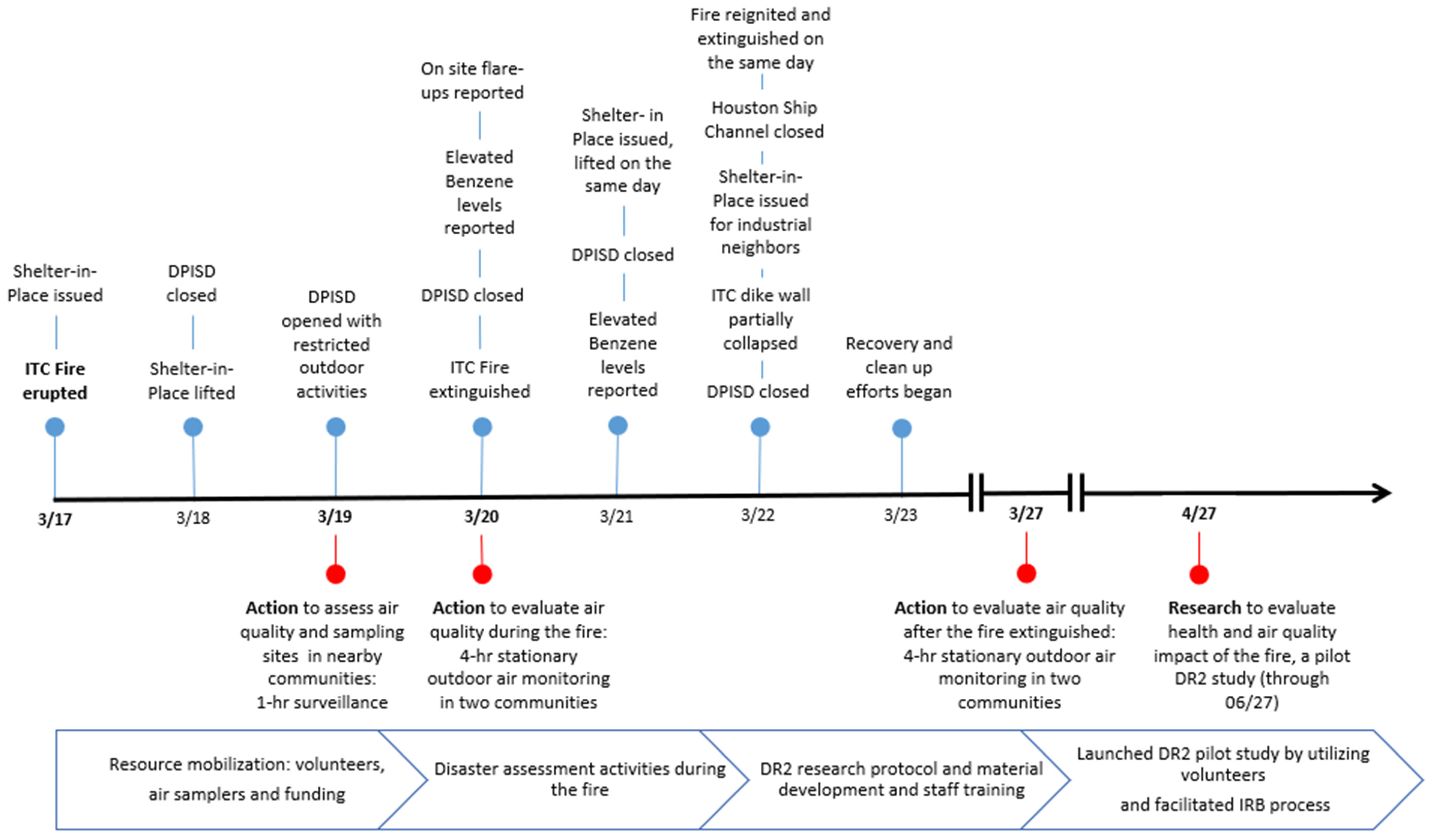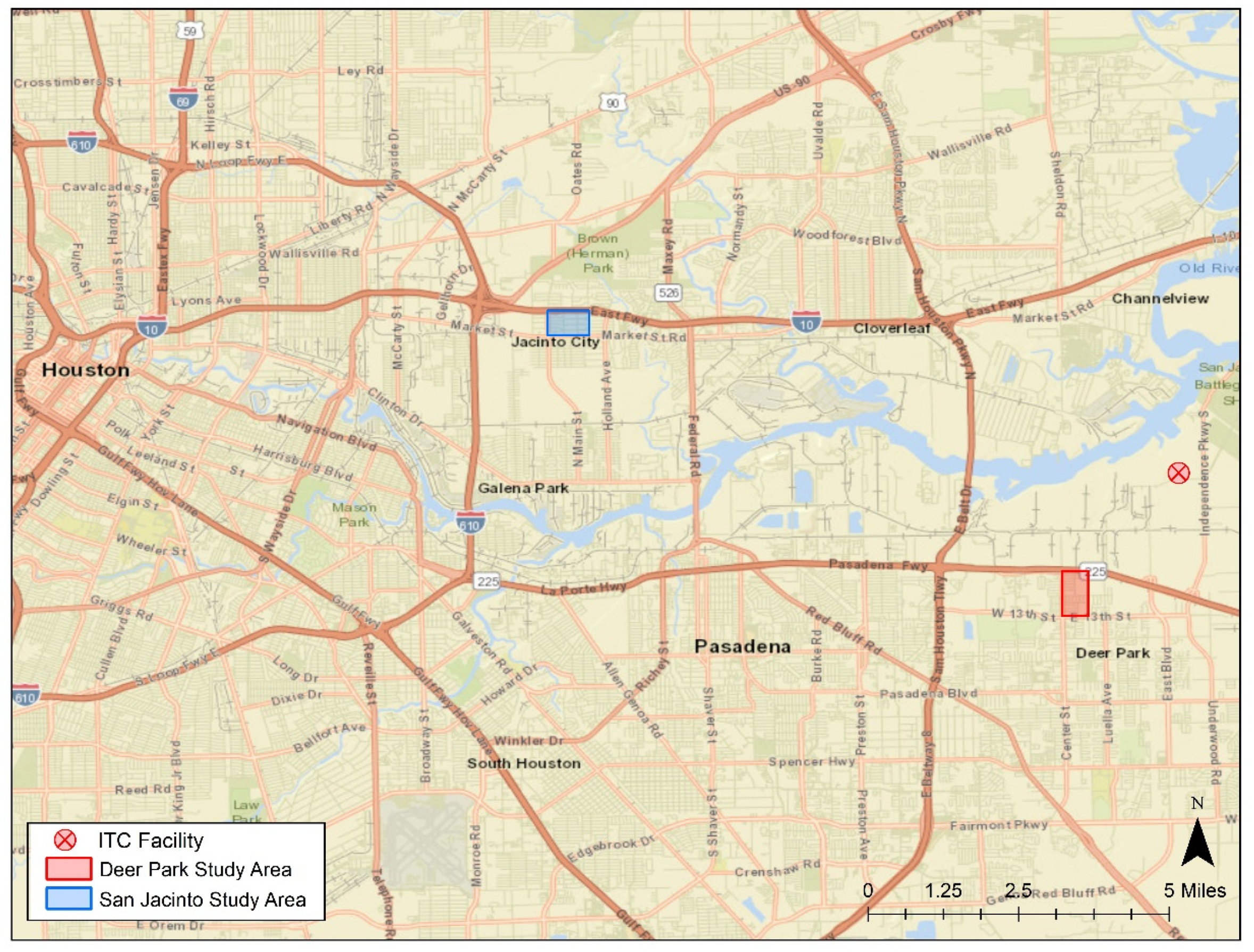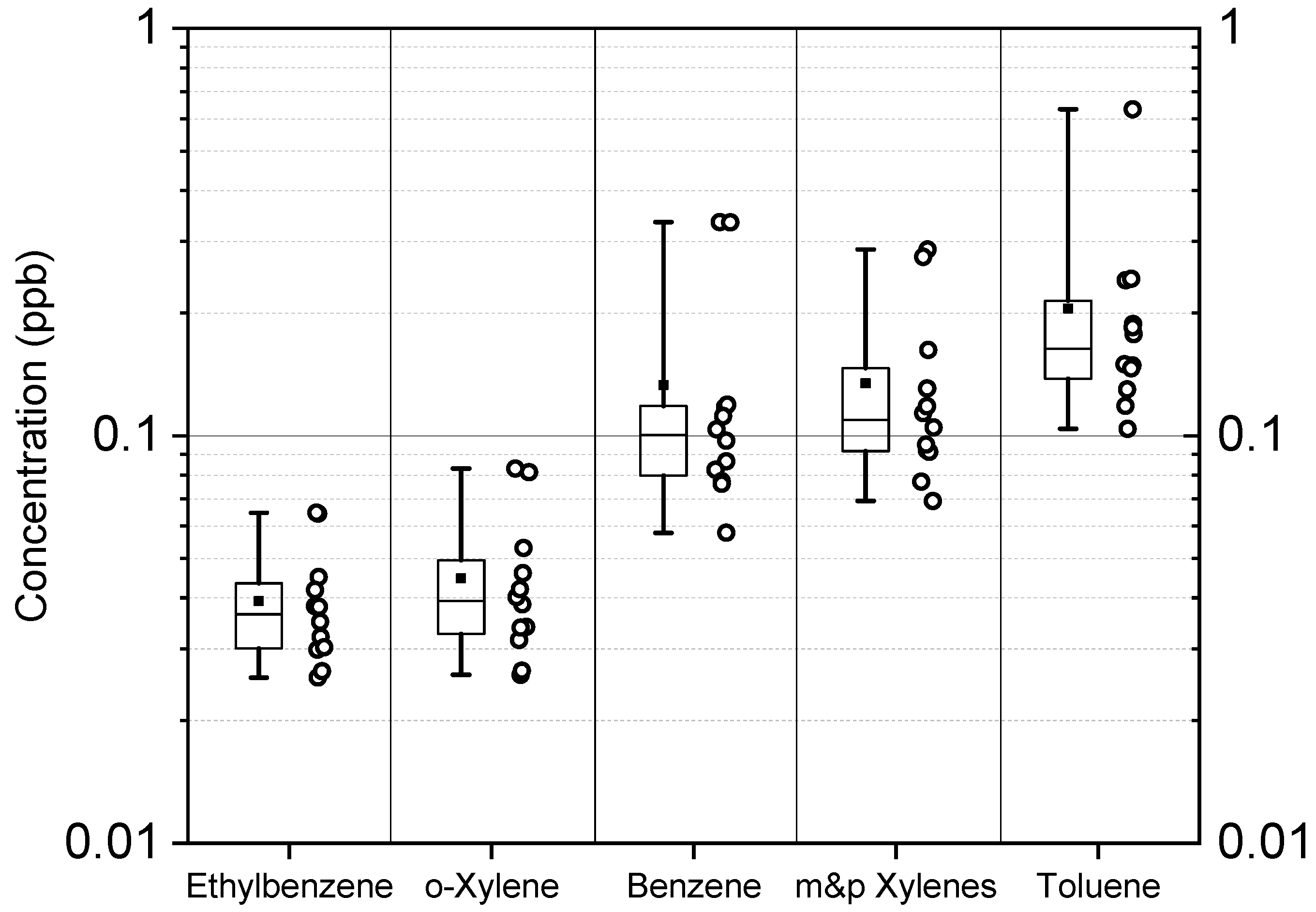The Intercontinental Terminals Chemical Fire Study: A Rapid Response to an Industrial Disaster to Address Resident Concerns in Deer Park, Texas
Abstract
1. Introduction
2. Materials and Methods
2.1. Community Description
2.2. Community Air Monitoring in Deer Park and Jacinto City During the Fire
2.3. DR2 Pilot Study in Deer Park a Month after the Fire
2.3.1. Residential Air Monitoring to Collect Baseline Data a Month after the Fire
2.3.2. Health Survey to Assess Health Effects During and Two Weeks After the Fire
3. Results
3.1. Impact of the ITC Fire on Community Air Quality
3.2. DeeP Fire Pilot Study Findings
4. Discussion
5. Conclusions
Author Contributions
Funding
Acknowledgments
Conflicts of Interest
References
- Click2Houston. ITC Deer Park Fire: Here Are the Resources You Need. 2019. Available online: https://www.click2houston.com/news/itc-deer-park-fire-here-are-the-resources-you-need (accessed on 28 March 2019).
- Deer Park Emergency Services. ITC Fire Updates. 2019. Available online: http://www.deerparktx.gov/1778/ITC-Fire (accessed on 12 June 2019).
- Trevizo, P. Month after ITC Explosion at Deer Park Plant, Fire Investigators Enter Tank Farm. 2019. Houston Chronicle. Available online: https://www.chron.com/news/houston-texas/houston/article/Month-after-ITC-explosion-at-Deer-Park-plant-13753517.php (accessed on 9 April 2019).
- United States Environmental Protection Agency. EJSCREEN. 2017. Available online: https://www.epa.gov/ejscreen (accessed on 22 March 2019).
- Stock, T.H.; Morandi, M.T.; Afshar, M.; Chung, K.C. Evaluation of the use of diffusive air samplers for determining temporal and spatial variation of volatile organic compounds in the ambient air of urban communities. J. Air Waste Manag. Assoc. 2008, 58, 1303–1310. [Google Scholar] [CrossRef] [PubMed][Green Version]
- Cloitre, M.; Garvert, D.W.; Brewin, C.R.; Bryant, R.A.; Maercker, A. Evidence for proposed ICD-11 PTSD and complex PTSD: A latent profile analysis. Eur. J. Psychotraumatol. 2013, 4. [Google Scholar] [CrossRef] [PubMed]
- Karatzias, T.; Shevlin, M.; Fyvie, C.; Hyland, P.; Efthymiadou, E.; Wilson, D.; Roberts, N.; Bisson, J.I.; Brewin, C.R.; Cloitre, M. An initial psychometric assessment of an ICD-11 based measure of PTSD and complex PTSD (ICD-TQ): Evidence of construct validity. J. Anxiety Disord. 2016, 44, 73–79. [Google Scholar] [CrossRef] [PubMed]
- Kroenke, K.; Strine, T.W.; Spitzer, R.L.; Williams, J.B.; Berry, J.T.; Mokdad, A.H. The PHQ-8 as a measure of current depression in the general population. J. Affect. Disord. 2009, 114, 163–173. [Google Scholar] [CrossRef]
- Ruggiero, K.J.; Del Ben, K.; Scotti, J.R.; Rabalais, A.E. Psychometric Properties of the PTSD Checklist—Civilian Version. J. Trauma. Stress 2003, 16, 495–502. [Google Scholar] [CrossRef]
- Kroenke, K.; Spitzer, R.L. The PHQ-9: A new depression diagnostic and severity measure. Psychiatr. Ann. 2002, 32, 509–515. [Google Scholar] [CrossRef]
- Kroenke, K.; Spitzer, R.L.; Williams, J.B.; Löwe, B. An ultra-brief screening scale for anxiety and depression: The PHQ–4. Psychosomatics 2009, 50, 613–621. [Google Scholar]
- Kroenke, K.; Spitzer, R.L.; Williams, J.B. The PHQ-9: Validity of a brief depression severity measure. J. Gen. Intern. Med. 2001, 16, 606–613. [Google Scholar] [CrossRef]
- Corson, K.; Gerrity, M.S.; Dobscha, S.K. Screening for depression and suicidality in a VA primary care setting: 2 items are better than 1 item. Am. J. Manag. Care 2004, 10 Pt 2, 839–845. [Google Scholar]
- USEPA. National Ambient Air Quality Standard. US Environmental Protection Agency. 2019. Available online: https://www.epa.gov/criteria-air-pollutants/naaqs-table (accessed on 13 July 2019).
- Quintana, P.J.; Dumbauld, J.J.; Garnica, L.; Chowdhury, M.Z.; Velascosoltero, J.; Mota-Raigoza, A.; Flores, D.; Rodríguez, E.; Panagon, N.; Gamble, J.; et al. Traffic-related air pollution in the community of San Ysidro, CA, in relation to northbound vehicle wait times at the US-Mexico border Port of Entry. Atmos. Environ. 2014, 88, 353–361. [Google Scholar] [CrossRef]
- Saha, P.K.; Zimmerman, N.; Malings, C.; Hauryliuk, A.; Li, Z.; Snell, L.; Subramanian, R.; Lipsky, E.; Apte, J.S.; Robinson, A.L.; et al. Quantifying high-resolution spatial variations and local source impacts of urban ultrafine particle concentrations. Sci. Total Environ. 2019, 655, 473–481. [Google Scholar] [CrossRef] [PubMed]
- Zhu, Y.; Hinds, W.C.; Kim, S.; Shen, S.; Sioutas, C. Study of ultrafine particles near a major highway with heavy-duty diesel traffic. Atmos. Environ. 2002, 36, 4323–4335. [Google Scholar] [CrossRef]
- Liu, L.J.S.; Slaughter, J.C.; Larson, T.V. Comparison of light scattering devices and impactors for particulate measurements in indoor, outdoor, and personal environments. Environ. Sci. Technol. 2002, 36, 2977–2986. [Google Scholar] [CrossRef] [PubMed]
- Wang, Z.; Wang, D.; Peng, Z.R.; Cai, M.; Fu, Q.; Wang, D. Performance assessment of a portable nephelometer for outdoor particle mass measurement. Environ. Sci. Process. Impacts 2018, 20, 370–383. [Google Scholar] [CrossRef] [PubMed]
- Ramachandran, G.; Adgate, J.L.; Pratt, G.C.; Sexton, K. Characterizing indoor and outdoor 15 minute average PM2.5 concentrations in urban neighborhoods. Aerosol Sci. Technol. 2003, 37, 33–45. [Google Scholar] [CrossRef]
- Reid, C.E.; Jerrett, M.; Tager, I.B.; Petersen, M.L.; Mann, J.K.; Balmes, J.R. Differential respiratory health effects from the 2008 northern California wildfires: A spatiotemporal approach. Environm. Res. 2016, 150, 227–235. [Google Scholar] [CrossRef]
- Landrigan, P.J.; Lioy, P.J.; Thurston, G.; Berkowitz, G.; Chen, L.C.; Chillrud, S.N.; Gavett, S.H.; Georgopoulos, P.G.; Geyh, A.S.; Levin, S.; et al. Health and environmental consequences of the world trade center disaster. Environ. Health Perspect. 2004, 112, 731–739. [Google Scholar] [CrossRef]
- Hoyos, C.D.; Herrera-Mejía, L.; Roldán-Henao, N.; Isaza, A. Effects of fireworks on particulate matter concentration in a narrow valley: The case of the Medellín metropolitan area. Environ. Monit. Assess. 2020, 192, 6. [Google Scholar] [CrossRef]
- Seidel, D.J.; Birnbaum, A.N. Effects of Independence Day fireworks on atmospheric concentrations offine particulate matter in the United States. Atmos. Environ. 2015, 115, 192–198. [Google Scholar] [CrossRef]
- TCEQ. 2019. Available online: https://www.tceq.texas.gov/cgi-bin/compliance/monops/agc_monthly_summary.pl?user_site=48_201_1039 (accessed on 13 July 2019).
- Han, I.; Symanski, E.; Stock, T.H. Feasibility of using low-cost portable particle monitors for measurement of fine and coarse particulate matter in urban ambient air. J. Air Waste Manag. Assoc. 2017, 67, 330–340. [Google Scholar] [CrossRef]
- Thoma, E.D.; Miller, M.C.; Chung, K.C.; Parsons, N.L.; Shine, B.C. Facility fence-line monitoring using passive samplers. J. Air Waste Manag. Assoc. 2011, 61, 834–842. [Google Scholar] [CrossRef] [PubMed]
- Chen, C.; Campbell, K.D.; Negi, I.; Iglesias, R.A.; Owens, P.; Tao, N.; Tsow, F.; Forzani, E.S. A New Sensor for the Assessment of Personal Exposure to Volatile Organic Compounds. Atmos. Environ. 2012, 54, 679–687. [Google Scholar] [CrossRef] [PubMed]
- Jerrett, M.; Donaire-Gonzalez, D.; Popoola, O.; Jones, R.; Cohen, R.C.; Almanza, E.; De Nazelle, A.; Mead, I.; Carrasco-Turigas, G.; Cole-Hunter, T.; et al. Validating novel air pollution sensors to improve exposure estimates for epidemiological analyses and citizen science. Environ. Res. 2017, 158, 286–294. [Google Scholar] [CrossRef] [PubMed]
- Bazyar, J.; Pourvakhshoori, N.; Khankeh, H.; Farrokhi, M.; Delshad, V.; Rajabi, E. A comprehensive evaluation of the association between ambient air pollution and adverse health outcomes of major organ systems: A systematic review with a worldwide approach. Environ. Sci. Pollut. Res. 2019, 26, 12648–12661. [Google Scholar] [CrossRef]
- Brunekreef, B.; Holgate, S.T. Air pollution and health. Lancet 2002, 360, 1233–1242. [Google Scholar] [CrossRef]
- Pietrzak, R.H.; Tracy, M.; Galea, S.; Kilpatrick, D.G.; Ruggiero, K.J.; Hamblen, J.L.; Southwick, S.M.; Norris, F.H. Resilience in the Face of Disaster: Prevalence and Longitudinal Course of Mental Disorders following Hurricane Ike. PLoS ONE 2012, 7, e38964. [Google Scholar] [CrossRef]
- Leitch, M.L.; Vanslyke, J.; Allen, M. Somatic Experiencing Treatment with Social Service Workers Following Hurricanes Katrina and Rita. Soc. Work 2009, 54, 9–18. [Google Scholar] [CrossRef]
- Errett, N.A.; Haynes, E.N.; Wyland, N.; Everhart, A.; Pendergrast, C.; Parker, E.A. Assessing the national capacity for disaster research response (DR2) within the NIEHS Environmental Health Sciences Core Centers. Environ. Health 2019, 18, 61. [Google Scholar] [CrossRef]
- Symanski, E.; An Han, H.; Han, I.; Whitworth, K.; McDaniel, M.; William, P.; Rammah, A.; Tee Lewis, T.; Delclos, G.; Craft, E.; et al. Enhancing Community Resiliency to Respond to Disasters: Academic-Government-Community Partnerships and Lessons Learned. Public Health Rep. 2019. Submitted. [Google Scholar]



| Deer Park | Jacinto City | |||||
|---|---|---|---|---|---|---|
| Pollutant | March 20 | March 27 | p-Value a | March 20 | March 27 | p-Value a |
| PM2.5 (µg/m3) b | 38.5 ± 4.1 | 14.4 ± 8.5 | <0.001 | 52.8 ± 6.4 | N/Ac | _ |
| TVOCs (ppb) | 79 ± 84 | 28 ± 40 | <0.001 | 46 ± 69 | 20 ± 13 | 0.006 |
| BC (µg/m3) | 0.90 ± 0.10 | 0.46 ± 0.15 | <0.001 | 1.30 ± 0.46 | 0.65 ± 0.33 | 0.002 |
| UFP (#/cm3) | 13,575 ± 4408 | 4895 ± 1566 | <0.001 | 26,888 ± 2275 | 40,958 ± 4688 | <0.001 |
| Pollutant | No. of Homes | Mean | Median | Range |
|---|---|---|---|---|
| PM2.5 (µg/m3) | 8 | 13 ± 6 | 12 | 3–28 |
| TVOCs (ppb) | 8 | 108 ± 98 | 72 | 17–536 |
© 2020 by the authors. Licensee MDPI, Basel, Switzerland. This article is an open access article distributed under the terms and conditions of the Creative Commons Attribution (CC BY) license (http://creativecommons.org/licenses/by/4.0/).
Share and Cite
An Han, H.; Han, I.; McCurdy, S.; Whitworth, K.; Delclos, G.; Rammah, A.; Symanski, E. The Intercontinental Terminals Chemical Fire Study: A Rapid Response to an Industrial Disaster to Address Resident Concerns in Deer Park, Texas. Int. J. Environ. Res. Public Health 2020, 17, 986. https://doi.org/10.3390/ijerph17030986
An Han H, Han I, McCurdy S, Whitworth K, Delclos G, Rammah A, Symanski E. The Intercontinental Terminals Chemical Fire Study: A Rapid Response to an Industrial Disaster to Address Resident Concerns in Deer Park, Texas. International Journal of Environmental Research and Public Health. 2020; 17(3):986. https://doi.org/10.3390/ijerph17030986
Chicago/Turabian StyleAn Han, Heyreoun, Inkyu Han, Sheryl McCurdy, Kristina Whitworth, George Delclos, Amal Rammah, and Elaine Symanski. 2020. "The Intercontinental Terminals Chemical Fire Study: A Rapid Response to an Industrial Disaster to Address Resident Concerns in Deer Park, Texas" International Journal of Environmental Research and Public Health 17, no. 3: 986. https://doi.org/10.3390/ijerph17030986
APA StyleAn Han, H., Han, I., McCurdy, S., Whitworth, K., Delclos, G., Rammah, A., & Symanski, E. (2020). The Intercontinental Terminals Chemical Fire Study: A Rapid Response to an Industrial Disaster to Address Resident Concerns in Deer Park, Texas. International Journal of Environmental Research and Public Health, 17(3), 986. https://doi.org/10.3390/ijerph17030986






